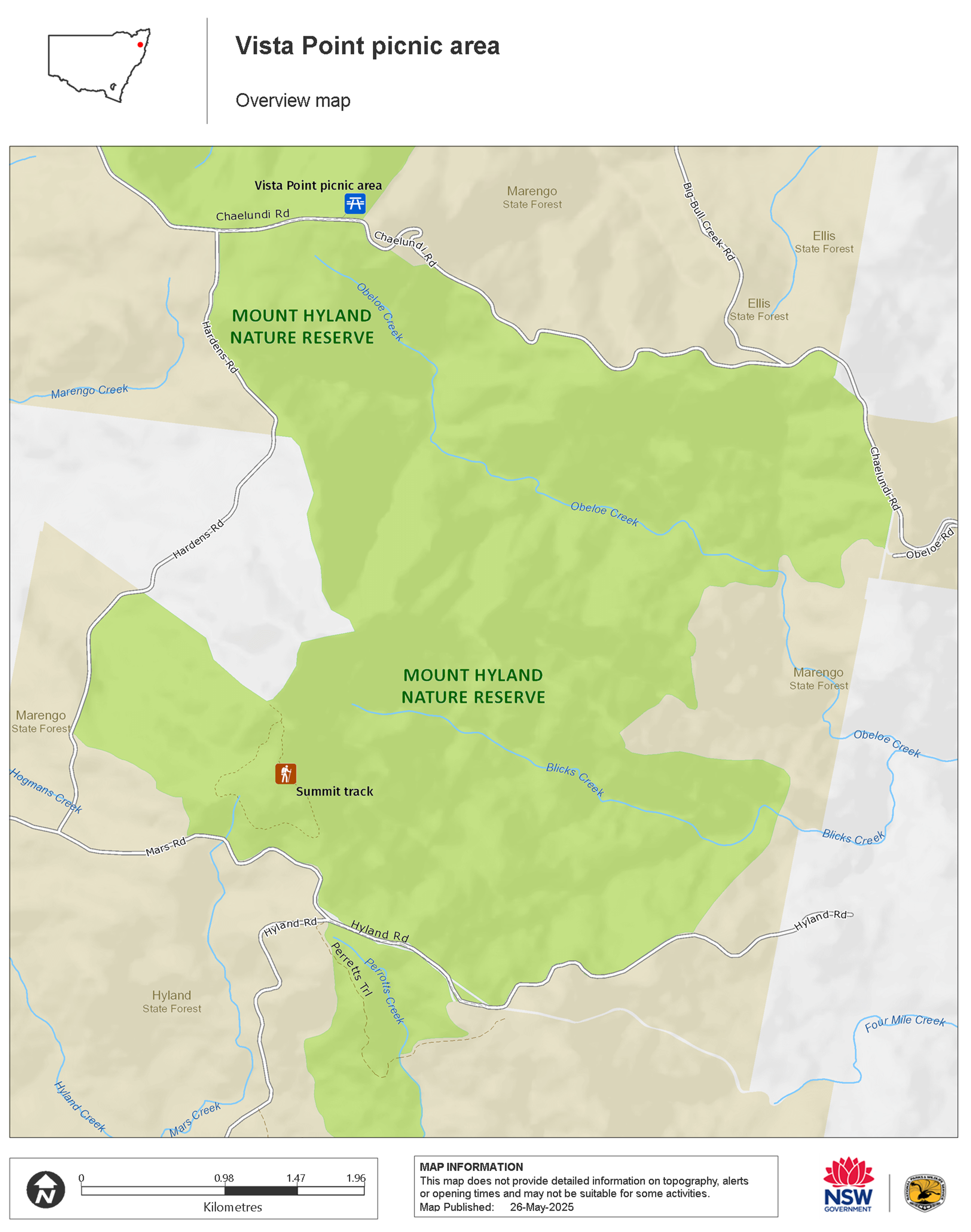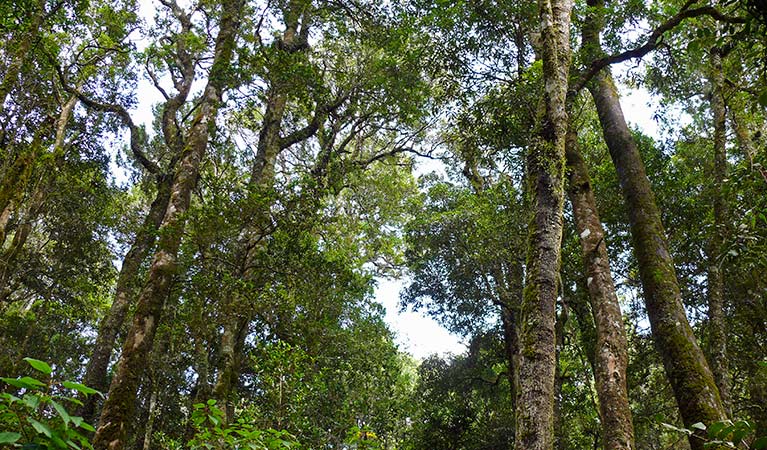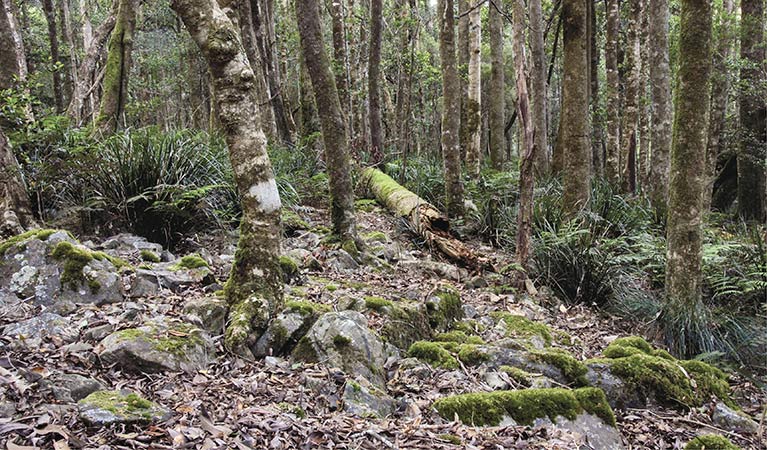Vista Point picnic area
Mount Hyland Nature Reserve
Overview
For scenic views across spectacular wilderness, Vista Point picnic area offers birdwatching and World Heritage rainforest in Mount Hyland Nature Reserve, near Dorrigo.
- Type
- Picnic areas
- Where
- Mount Hyland Nature Reserve in North Coast
- Accessibility
- Hard
- What to
bring - Hat, sunscreen, drinking water
- Please note
- The weather in the area can be extreme and unpredictable, so please ensure you’re well-prepared for your visit.
- There is limited mobile reception in this park
- Remember to take your binoculars if you want to go bird watching
There’s no need to book ahead for this magnificent lunch spot with superb mountain views. Tucked away in Mount Hyland Nature Reserve, Vista Point picnic area boasts breathtaking scenic views across vast wilderness. Located between Dorrigo and Grafton, this wild and remote spot is a short detour off Chaelundi Road, ideal for those who love bushwalking and birdwatching, and nature-lovers on a 4WD tour.
Stop and inhale the pristine rainforest air and feel the tranquillity descend. As you unwrap your sandwiches, gaze across the million-dollar views of Chaelundi Wilderness to the incredible Gibraltar Range National Park over 70km away.
The crisp clear days of autumn and winter are perfect for taking in the 180-degree vista. Be sure to keep an eye on the sky as majestic wedge-tailed eagles are often seen surfing the updrafts near this sky-high picnic spot.
Map

Map legend

Local alerts
For the latest updates on fires, closures and other alerts in this area, see https://uat.nswparks.cloud/things-to-do/picnic-areas/vista-point-picnic-area/local-alerts
General enquiries
- National Parks Contact Centre
- 7am to 7pm daily
- 1300 072 757 (13000 PARKS) for the cost of a local call within Australia excluding mobiles
- parks.info@environment.nsw.gov.au
Park info
- in Mount Hyland Nature Reserve in the North Coast region
Mount Hyland Nature Reserve is always open but may have to close at times due to poor weather or fire danger.
Visitor info
All the practical information you need to know about the Vista Point picnic area.
Maps and downloads
Learn more
Vista Point picnic area is in Mount Hyland Nature Reserve. Here are just some of the reasons why this park is special:
Famous wildlife residents

One of the more famous animals that are protected within this isolated reserve is the Hastings River mouse. Once thought to be extinct in NSW, it was rediscovered in the early 1980s. Other threated animals found in the area include the long-nosed potoroo and spotted-tailed quoll. Another of the fascinating animals protected within this rainforest remnant is the threatened pouched frog. Only 2cm in length, the male frog has two pouches on either side, which are used to carry the baby tadpoles after they've hatched.
- Summit walking track A loop through World Heritage rainforest, Summit walking track offers spectacular scenic views, birdwatching and picnic opportunities in Mount Hyland Nature Reserve, near Dorrigo.
- Vista Point picnic area For scenic views across spectacular wilderness, Vista Point picnic area offers birdwatching and World Heritage rainforest in Mount Hyland Nature Reserve, near Dorrigo.
Gumbaynggirr country

Mount Hyland Nature Reserve is located within the Traditional Lands of the Gumbaynggirr People. Aboriginal people in the area have a strong connection to their traditional lands and maintain connection through conservation and resource management. Sites of high cultural significance are located along the traditional walking routes between Boyd River and high country around the village of Ebor.
Hyland history

Mount Hyland was named after an early settler to the area who established a cattle station to the south of the mountain range. Hyland lived a basic existence in a slab shelter built from nearby stringybark trees. Although life was tough and he moved on, his name remains.
World Heritage rainforest

This unique patch of high altitude rainforest forms part of the World Heritage-listed Gondwana Rainforests of Australia. These cool temperate forests are only found at altitudes over 1,000m. Interestingly, Antarctic beech trees are absent from this patch of rainforest, possibly due to fire or drought.
Education resources (1)
General enquiries
- National Parks Contact Centre
- 7am to 7pm daily
- 1300 072 757 (13000 PARKS) for the cost of a local call within Australia excluding mobiles
- parks.info@environment.nsw.gov.au
Operated by
- Dorrigo Rainforest Centre
- May to August 9am to 4pm daily. September to April 9am to 4.30pm daily. Closed Christmas Day.
- 02 6657 5913
- dorrigo.rainforestcentre@environment.nsw.gov.au
- 142 Dome Road Dorrigo Mountain NSW 2453
Park info
- in Mount Hyland Nature Reserve in the North Coast region
Mount Hyland Nature Reserve is always open but may have to close at times due to poor weather or fire danger.
What's nearby:
Things to do (66)
- 4WD touring (2)
- Aboriginal culture (3)
- Adventure sports (1)
- Birdwatching and wildlife encounters (23)
- Cafes and kiosks (1)
- Canoeing/paddling (3)
- Cultural heritage (1)
- Cycling (3)
- Environmental appreciation/study (1)
- Geotourism (3)
- Historic heritage (3)
- Photography (2)
- Picnics and barbecues (14)
- Road trips and car/bus tours (3)
- Sightseeing (42)
- Surfing (1)
- Swimming (3)
- Visitor centres (1)
- Walking (38)
- Waterfalls (23)
- Wildflowers (seasonal) (7)

